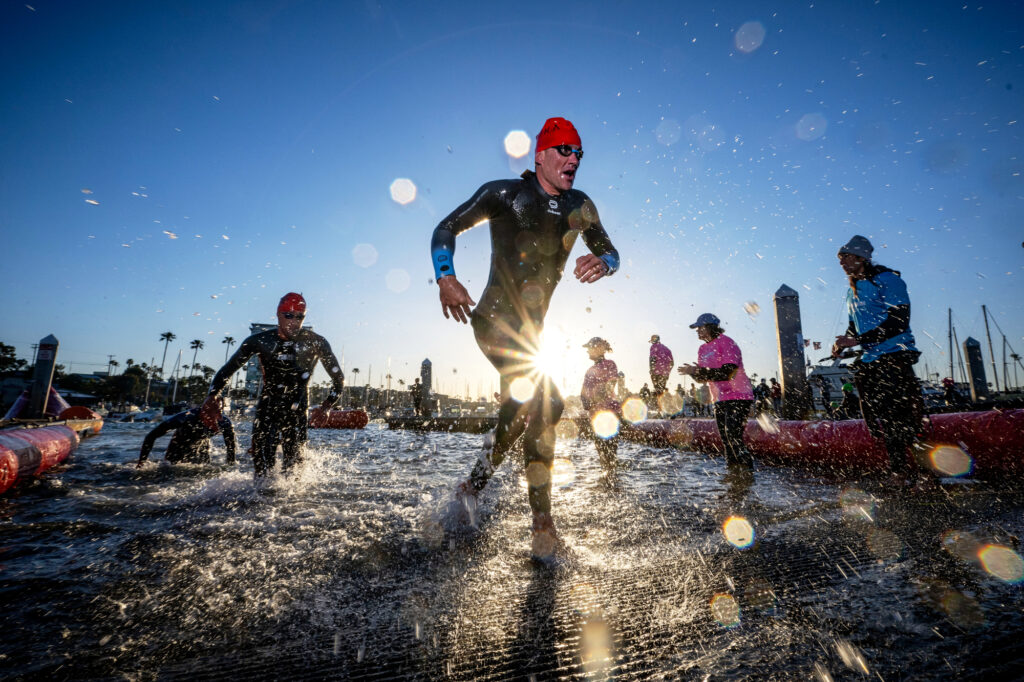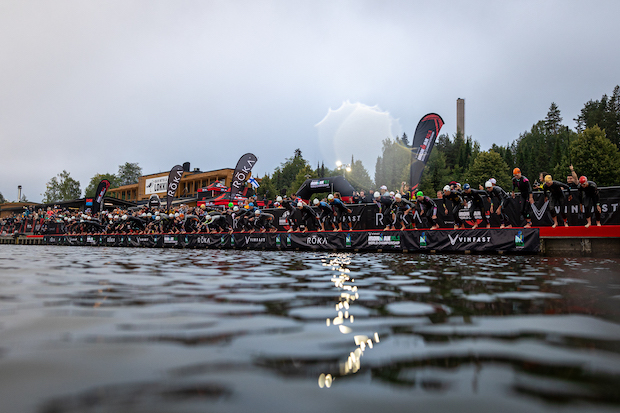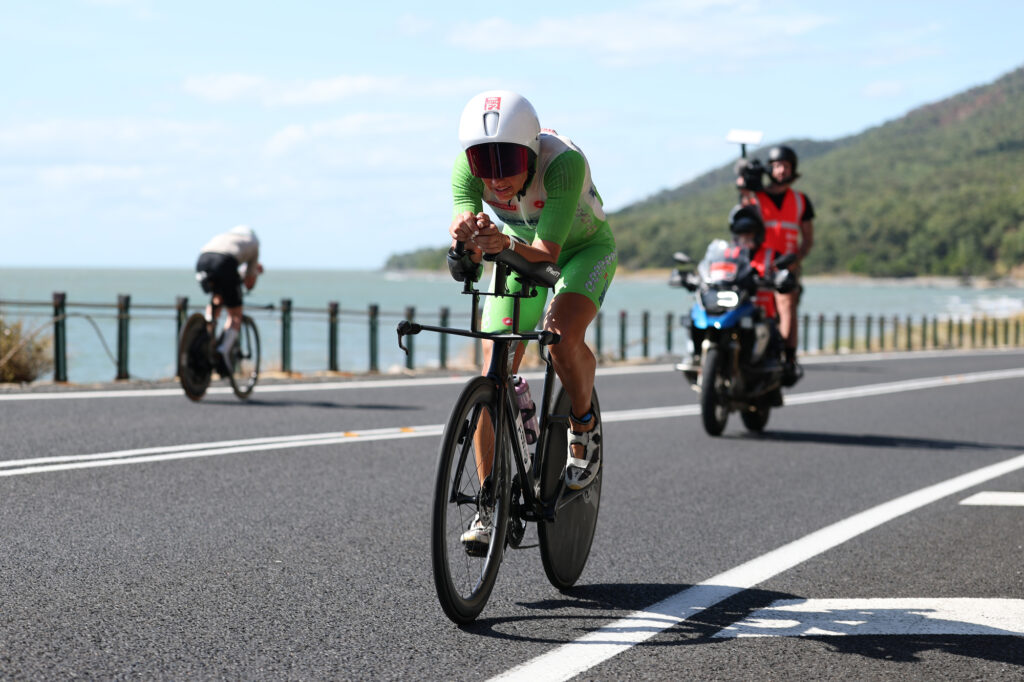Originally published at: Going Pro: Is It Too Easy To Earn A Pro License in Long-Distance Triathlon? - Slowtwitch News

Photo: Donald Miralle/IRONMAN.
There isn’t another sport quite like triathlon when it comes to the pro ranks. Triathlon has no teams and, therefore, no drafts into professional leagues and, unlike many other sports, amateurs can go toe-to-toe with pros at competitions around the globe. Organizations like the NBA and MLB have altered how people look at professional sports, which is why the realm of pro triathlon is such a funny and interesting little world. Today, we are kicking off a mini-series that will take a deeper dive into professional triathlon, and we will get started with the root of it all: how one becomes a pro in the sport, how this process differs around the world, and whether it is too easy to earn pro status as a triathlete — specifically when it comes to long-distance racing.
Pro Cards Around the World
In the U.S., an athlete can become a professional triathlete through a number of routes, all of which are determined by USA Triathlon (USAT). One of these paths toward going pro is to finish within eight percent of the winning elite time in three separate USAT-sanctioned events that offer a prize purse of $5,000 or more.
Another option for Americans is to finish in the top 10 overall and within eight percent of the winner’s time at the World Triathlon age group world championships. If an athlete is hoping to compete at longer races, they need to finish in the top 10 overall among age groupers at the IRONMAN World Championship (no time criteria, just straight top 10). Athletes can also earn a pro card in the U.S. through a top-five finish at the USAT age group nationals or USAT Collegiate Club National Championships.
In the U.K., British Triathlon has slightly tougher standards that must be met in order to obtain a pro racing license. For short-course, draft-legal racing, British athletes can earn their pro card if they finish within three percent of the winner’s time at a World Triathlon Senior Continental Cup event. For longer racing, a Brit must compete at the world or European middle- or long-distance championships, and finish within eight percent of the winning time. Brits can also secure their pro license by finishing in the top 40 overall (not among age groupers, but of all athletes) at the IRONMAN World Championship or 70.3 worlds.
In Australia, the criteria gets a little more challenging. There are many routes to a pro card Down Under, but none are easy. AusTriathlon, the governing body of the sport in Australia, lists multiple age group events at which athletes can earn a professional license (such as the IRONMAN Asia Pacific Championship and the Australian Long Distance Triathlon Championships), but they will have to podium to meet the pro standard.

Photo: Ville Kaskivirta for IRONMAN
A top-five result at the World Triathlon age group championships, IRONMAN World Championship, or 70.3 worlds will also book a triathlete their pro license, but they must be within five percent of the fastest age grouper at the race. An overall age group win (beating all racers, not just winning a specific age category) at an IRONMAN, 70.3, or Challenge race can also deliver an athlete their pro card, but the event must feature a pro field and the athlete’s time has to be within five percent of the professional winner’s result.
Too Easy?
Becoming a professional triathlete is by no means easy. The people who earn their pro cards are not stumbling into professional triathlon. They’re remarkable athletes who have trained hard to get where they are. However, just because it’s not necessarily easy to become a pro doesn’t mean that the process shouldn’t be tightened up a bit with more difficult qualification standards.
Take a look at the results of any high-profile IRONMAN or 70.3 event at which top pros raced. Scroll to the bottom of the professional standings and check out the times and overall placing of the bottom pros. Often there will be multiple pros who were beaten by many (sometimes upwards of 50) age group athletes. Of course, there is the case to be made that these pros could simply have had bad days — perhaps they were racing through illness or injury, or maybe they got a flat on the bike — but a quick search of many of these names will show that they are repeat offenders — athletes who compete as pros in multiple events a year and lose to dozens of age groupers at each race.
One reason athletes can get themselves into this position is because IRONMAN and 70.3 racing has no tiers when it comes to professionals. In other sports, there are levels to being a pro. In basketball, the NBA is at the top, there is the NBA’s farm team system, and there are countless leagues in Europe, Asia and beyond, all of which vary in overall player skill level. If a player is drafted to the NBA, he has to prove himself and earn his spot on the roster every game, otherwise he will be cut and eventually forced to settle for one of these lower leagues. This is even the case with the draft-legal triathlon system, which sees athletes working their way up the ranks from Continental Cup races to the World Cup and finally to World Triathlon Championship Series events. (We will take a deeper dive into the draft-legal system in Part 2 of this mini series.)
In long-distance triathlon, it’s almost the opposite. Athletes can get their pro cards by finishing within whatever percentage of the elite winners’ times at less-competitive races, but then they are free to enter any pro event, competing with the likes of Kristian Blummenfelt and Lucy Charles-Barclay and not coming anywhere close to the qualifying standard percentage they hit to earn their pro card. This would be like a basketball player earning his pro status in Germany and then being permitted to play in an NBA game against Lebron James simply because he is recognized as a pro. As one could guess, this would not end well for that player. It doesn’t end well in triathlon, either, as athletes who eked out pro cards thanks to their countries’ relaxed qualifying standards are routinely beaten by top pros by 40 or 50 minutes in 70.3 races and even more in full-distance IRONMAN events.

Photo: Cameron Spencer/Getty Images for IRONMAN
There is also the matter of maintaining one’s pro card. In many countries, it is easier to keep a pro card than it is to get one in the first place. Once more looking to the NBA as an example, when a player’s contract is renegotiated, his whole season is used to determine if he will get re-signed to his team, not just one or two standout performances. Again, triathlon does the opposite, and a professional can have 10 sub-par races in a season and still renew his or her pro card thanks to one performance in a slower race that was good enough to meet the elite criteria for their country.
Self-Selection
A big reason that there is such a huge discrepancy in the pro ranks of triathlon is because of ego. It undoubtedly feels good to be able to tell people you’re a professional athlete, and in a sport like triathlon (which many people know nothing about), a person can say they’re a pro without many follow-up questions. The subtext is simply, “I’m fast, I’m good at this sport,” and the expectation is that admiration will follow. Once again, there is nothing wrong with being slower than the best triathletes in the world, but before becoming a pro, one should maybe ask the question, “Do I have what it takes?”
This is the question on which the Deutsche Triathlon Union (or DTU, the German governing body in the sport) operates when it comes to professional licenses. In Germany, the DTU has no performance-based requirements standing between an athlete and a pro card. Instead, athletes simply pay a fee, submit the results of a medical examination, and register with the German National Anti-Doping Agency. After that, they are officially pros.
With that sort of system in place, one might assume that there are hundreds and hundreds of German pros running around Europe getting smashed at races every weekend, but that is not the case at all. In Germany, being a pro is not about the clout or the praise one gets for reaching this level, but rather for the pursuit itself. Unlike North Americans and athletes from other parts of the world, Germans are not satisfied with simply owning the title of professional triathlete, and they would be embarrassed to be passed by dozens of age groupers at a race as a pro. This sort of self-selection process works wonders for the DTU, as they still produce top-end talent (look at Anne Haug and Jan Frodeno, to name just a couple of athletes) without watering down the pro fields in races.
The Fix?
There are several ways this could potentially be fixed. One is to simply tighten professional qualification standards across the board. This would make it so only the most deserving athletes elevate to professional status in triathlon. Another is to keep the qualification standards as they are, but to add a tiered system to long-distance triathlon. Adopt the World Triathlon format and have a ladder athletes must climb in order to reach the most competitive and highly regarded races.
This is of course much easier said than done, and it is unlikely triathlon will see a revamping of its professional standards any time soon. It’s worth thinking about, however, and if you’re looking at going for your pro card, think about what you want as a pro: would you like to compete with the best and truly race every event you enter, or are you happy to simply possess the title without owning the performances to back it up?